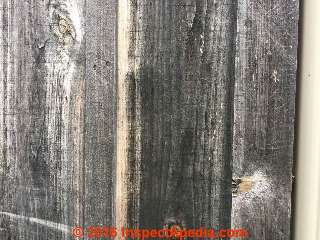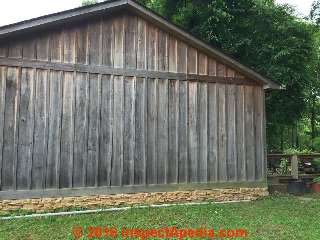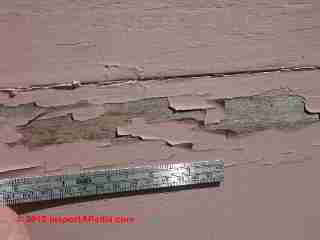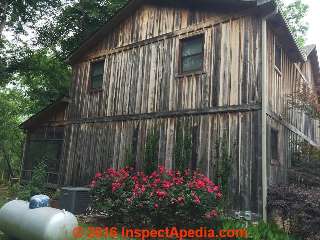 Wood Siding Stain Removal, Cleaning, New Stain or Paint Application
Wood Siding Stain Removal, Cleaning, New Stain or Paint Application
Guide to removing stains on wood siding, then applying stain or paint coatings
- POST a QUESTION or COMMENT about choosing among types of wood siding
Wood siding stain removal & wood siding paint or stain application procedures:
This article discusses methods of removing ugly dark stains from wood siding & trim and how to choose a paint or stain coating to preserve wood siding or to cover stains & improve its appearance. Above: black stains, probably algae or fungus, discoloring cypress wood siding on a home in Arkansas in the U.S.
This article series discusses wood siding material choices & installation, building trim, exterior caulks and sealants, and choices and application of exterior finishes on buildings: paints, stains used on siding or trim.
InspectAPedia tolerates no conflicts of interest. We have no relationship with advertisers, products, or services discussed at this website.
- Daniel Friedman, Publisher/Editor/Author - See WHO ARE WE?
Guide to Wood Siding Staining: Stain Removal & Stain vs Paint Coating Choices & Procedures
Reader Question: How to paint or stain a building to address dark stains on cypress siding
Hello, I am a 73 year old retiree living in Arkansas. I would like to find information on the care for our cypress home. I am not too good at computers and hope you can point us in the right direction to obtain help from your technical people or your website.
Our home is 7 years old and when we built we chose cypress external siding believing it was a very durable wood and would naturally turn a nice gray color and would not require a lot of maintenance.
We elected not to seal it. Needless to say we probably did not do the proper research. While the cypress siding is still in very good condition with no cracking and no warping the color is not what we had hoped for.
Some days it is ok but as weather and humidity changes some parts of the siding will turn into a blackish color but go away as weather changes again. Also some areas have aged more than others. We are at somewhat of a loss as to what we should do.
My basic questions are as follows.
- Will the unsightly appearance go away as it ages more or will it get worse?
- If the black coloring is a mold or mildew is it harmful to the wood and can it be treated?
- Should we go ahead and clean and seal the wood realizing the quite large expense will need to be repeated every 3-4 years. If so can you offer any good product choices.
We are retired (fixed income) and are searching for the best solution both for the cost and the proper maintenance of the cypress while hopefully also gaining a much better appreciation for the color and appearance.
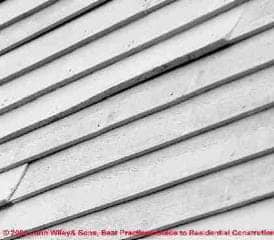 Any help would be appreciated, best regards, - Anonymous, in Arkansas, by private email 2016/05/18
Any help would be appreciated, best regards, - Anonymous, in Arkansas, by private email 2016/05/18
Article Contents
How cypress & other wood siding products weather & wear on a building
Reply:
Thank you for the interesting question - it helps us realize where we need to work on making our text more clear or more complete. A competent onsite inspection by an expert usually finds additional clues that would permit a more accurate, complete, and authoritative answer than we can give by email alone.
You will find additional depth and detail in articles at our website including in some wood siding articles I'll recommend just below.
That said I offer these comments:
Please use the page top or bottom CONTACT link to send me photos of the problem areas of your siding, shown both from a distance (whole side of the building) and close-up views of the stained areas ( but in-focus please).
I'd also like to see photos of all sides of the home and to know directions faced as that helps understand the home's exposures and weathering conditions. With that data I can comment more specifically about your siding and its areas of discoloration.
Note; photos in this section illustrate black stains on the the cypress-sided home being discussed.
Wood siding, especially left natural, un-stained and un-treated weathers and changes color with age. New cypress siding is a rich honey color but it tends to weather to a dark gray.
I agree that cypress is in general a rather durable wood species in siding applications, as it's insect and rot resistant, in part because of oils in the wood itself. .
Really? But despite marketing promises of beauty, wood siding on a building does not normally weather or change color uniformly over the whole building on all sides in all locations.
The colors on a wood-sided building will not be uniform on the building and will vary as follows:
- In areas of wood siding close to ground where a wall is exposed to water splash-up from roof drainage siding may be darkened by algae or mold and will generally show more wear; unprotected some siding materials in this location will rot or invite insect attack, though cypress is rather insect and rot resistant.
See SIDING DAMAGE by SPLASHBACK - In areas of wood siding exposed to more shade, plantings close to the building, sources of dampness, siding is more likely to be discolored by algae.
See TREES & SHRUBS, TRIM OFF BUILDING
and also
See ALGAE, FUNGUS, LICHENS, MOSS - In areas wood siding exposed to sunlight siding is more likely to weather to a gray color and over time, depending on wood species, such siding may photo-oxidize and wear faster than in other areas, including splits and checks;
What to do about dark stained areas on your wood siding before painting or staining
Clean Wood Siding Gently to Avoid Power Washer Marks
I think most of that back is fungus or perhaps a black algae. You can power wash gently with deck cleaner. Risks include sloppy uneven power washer marks, raised wood grain, blowing get water into walls.
Reader follow-up:
Thanks ..., I think you are right. I believe your advise to "gently" clean the wood siding is a very important approach that I was completely uninformed about. I was thinking power wash with a very tight stream was necessary and I realize now how much damage I could have done.
Reply:
Yes, watch out; power washing is faster, cheaper and if very very expertly done leaves few ugly marks but more common we see horrible cuts and gouges and uneven surface coloring as the sprayer switches direction at the end of each stroke; plus the raised grain problem.
Meanwhile spraying from a distance more gently removes less crud so we're back to maybe a combined approach. I might try garden hose sprayer and bristle brush approach - much more labor time.
Apply A Preservative Stain after Cleaned Siding is Dry
You might consider having the siding stained with a preservative type stain that soaks into the wood and does not leave any surface coating (that will peel and look ugly). That will both extend the life of the siding and make the color more what you want. The cypress siding industry recommends either letting the siding weather naturally to a gray color or applying a clear sealer.
Dark ugly areas of the siding may need to be gently cleaned before staining, then let dry.
Use a bleach solution or siding cleaner (discussed in a moment). Beware of very aggressive power washing that can raise the grain of the wood leaving it fuzzy, and worse, drive water into the walls causing mold problems.
Watch out: Dark ugly areas of your cypress siding may be due to mold growth on or in those areas. Cleaning of those areas may be necessary before applying a coating, regardless of whether you choose to use a stain or a paint.
That's because you'll want to remove the dark mold or fungus as much as you can without damaging the wood, and because if you don't do so, you may find that the mold will continue to grow underneath any new coating, adding to future discoloration. You cannot formulate your own mold-resistant paint or stain but you can buy mold-resistant coatings made by the manufacturer.
Is it a mold or is it mildew? Lots of sources, even the US FPL, confuse mold and mildew, so you will probably find the term "mildewcide" rather than "fungicide" on some paint or stain products. Mildew, as we explain at x, is a subgroup of the family of molds but one that grows only on living plants.
So unless you side your home in grape leaves, you won't find mildew on the siding. Not ever. It's mold but it's not mildew.
See MILDEW PHOTOGRAPHS BUILDINGS ? if you care for details.
Bleach Formula to Clean Stained Siding
You can try a simple bleach-in-water solution to wet the dark areas of mold growth on siding, followed by gentler scrubbing along the grain with a soft brush.
But be sure to wash the siding thoroughly and quickly enough to avoid bleach run-down rivulets that leave ugly white lines on the siding.
And be sure to let the treated areas dry thoroughly (below 18% moisture level in the wood) before continuing with stain or paint application.
Formula for Wood Siding or Trim Cleaning Solution to Remove Algae, Black Molds, Dark Stains |
|
| Stain Removing / Cleaning Solution Ingredient | Amount of Ingredient |
| Powdered household detergent Household liquid bleach (sodium hypochlorite 5%) Water |
1/3 cup / 0.07 L or 78 ml 1 quart U.S. / 0.95 L 3 quarts U.S. / 2.8 L |
Alternative Wood Stain Cleaning Formula |
|
1 part liquid household bleach (sodium hypochlorite 5%) Detergent, liquid or powdered (precise measurement not critical, don't over-do it or you'll have a hell of a time washing off the suds and soap) 2 to 4 parts water |
|
Notes to the table above
Source: US FPL, Williams & Feist 1999 cited below
At BLACK or GREEN ALGAE STAIN REMOVE / PREVENT a similar formula from USDA adds 2/3 cup of TSP or we suggest, TSP substitute, noting that trisodium phosphate is no longer used as a cleaning agent because it is an environmental contaminant. However substitute products may be available.
Watch out: don't leave a bleach solution too long on wood without rinsing or you'll find it's over-bleached and will show up as too light or even white under stains.
Watch out: Be sure to wear rubber gloves when cleaning with this solution and to protect your eyes, skin, lungs, and clothing from bleach.
Watch out: Be careful not to add a cleaning agent to bleach that can cause production of toxic chlorine gas. Any cleaner that contains ammonia, added to bleach, will react to form toxic or fatal chlorine gas.
Staining Cypress Siding vs Painting It
Cleaning, prepping, and staining any wood sided building will be costly, so it's not something homeowners will be happy to repeat every 3-4 years. Painting will generally be more costly both at initial application and certainly when re-painting is necessary.
Properties & Application of Siding Stains
Cypress siding will absorb semi-transparent stains that in turn protect cypress or any wood siding from both water (the siding stain typically contains a waterproofing / preservative agent) and from photo-oxidation.
I prefer pigmented stains when we are trying to make color on a building more uniform, and I like penetrating semi-transparent stains for that purpose in part because they don't build-up a "skin" that ultimately peels and makes re-coating very expensive.
Differences among penetrating stains, latex semi-transparent stains & latex opaque stains
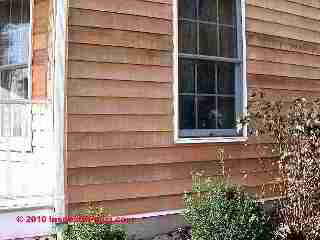 Penetrating stains under modern formulations, are a water repellent preservative (WRP) to which pigments have been added to produce a semi-transparent stain. These products offer the best protection of wood surfaces that are not to be painted.
Penetrating stains under modern formulations, are a water repellent preservative (WRP) to which pigments have been added to produce a semi-transparent stain. These products offer the best protection of wood surfaces that are not to be painted.
In our photo a transparent stain applied to wood siding with not very attractive results.
That's because the product combines chemicals to help the wood surface repel water, with a wood preservative to help the wood resist insects and wood-destroying rot-fungi, along with a third ingredient, a coloring pigment that both makes the wood surfaces on the building more uniform in appearance and at the same time time protects the wood from UV radiation in sunlight.
Protecting the wood from sunlight protects it from photo-oxidation and thus extends the life of the material.
Non-penetrating stains include latex semitransparent stains, latex opaque stains, and oil-based opaque stains.
Latex semitransparent stains look much like oil-based semitransparent stains after application to the building, but the US FPL points out that latex products form a thin film coating that does not penetrate the wood as do penetrating stains or some oil-based coatings.
I've seen latex stains that formed small flake-peeling areas on the surface.
Latex opaque stains use a solid color - their formula is similar to latex semi-transparent stains but the solid color stain contains more pigment., thus it forms a thicker film and has more hiding power to cover discolorations on the building surface. Keep in mind that no opaque stain will have as much hiding power as a true paint.
That's why the manufacturers use the word "opaque" in the product description.
An advantage of using a latex stain (or paint too for that matter) over oil based products is that latex-based coatings tend to dry faster - a consideration if you cannot count on 24 hours or longer of dry weather after the coating job is complete.
My opinion is that a latex coating also might tolerate being applied over wood with a higher moisture content that would cause bubbling or adhesion failures in a oil coating.
Moisture molecules can penetrate through and escape a latex coating while they are more likely to be trapped by an oil-based coating.
The opaque latex stain failure shown just below is discussed
at PAINTING MISTAKES and was observed on a historic home whose paint job was failing even before the job was finished
. I think that this failure was due to failure to apply a proper primer or over-thinning of the coating product at the time of application. That evidence was supported by our field inspection and by our forensic lab examination of failure samples, but the painting contractor never admitted to thinning the product nor anything else.
See details at PAINT FAILURE LAB ANALYSIS
Above: failure of a latex-based semitransparent stain on a home.
[Click to enlarge any image]
Oil based opaque stains are also referred to as "solid color" stains.
An oil-based opaque stain, unlike the latex stains cited above, offers the advantage that because of the solvents used in its formula, it penetrates the wood, thus adhering better and preserving better than a surface-only type coating.
Oil-based opaque stains are particularly suitable for use when re-coating a wood exterior that was previously coated with another penetrating coating such as a water repellant or a water repellant-preservative product.
The US FPL points out that
Oil-based opaque (solid-color) stains are less flexible than latex stains and more prone to crack and flake, particularly if applied as a single coat over flat-grained wood.
These stains provide good service life if applied in multiple coats, which build up the film, but they will not give the same appearance as a penetrating stain. (US FPL, Williams & Feist 1999)
Advantages of using a penetrating stain:
- Preservation of the wood by water repellency, insect resistance, rot resistance, sunlight resistance
- Deeper penetration into the wood by a stain than by paint, improving wood treatment, durability, protection
- No need to use a primer coat as is needed in painting, though depending on how the wood takes the stain and its appearance you may still end up applying two coats --- it depends.
- Penetrating stains do not suffer the cracking and peeling problems that plague painted-film coatings on wood surfaces outdoors
- A wood surface that has been coated with a penetrating stain won't need to be scraped and sanded before re-coating, thus the cost of subsequent stain jobs should be much lower than the cost of subsequent paint jobs on a building.
How long do preservative stain coatings last?
However some cypress wood siding industry sources (cypressinfo.corg) note that pigmented semi-transparent preservative stains last (in their view) for just a year and a half to two years. That's interesting;
I think the durability of the siding stain will vary quite a bit depending on how well the surface is prepared (clean, dry), the selection of the stain product, how it is applied, and the weathering factors I cited earlier in these notes. And the U.S. FPL experts and I seem to be in agreement. The following excerpt is from a US FPL publication on wood siding:
The durability of a stain system is a function of the formulation (amount and type of pigment, resin, preservative, and WR), the surface characteristics of the wood species, the quantity of material applied to the wood surface, and the amount of sunlight to which the finished surface is exposed.
In the 1950s, the USDA Forest Service, Forest Products Laboratory (FPL) developed a natural finish aimed at overcoming the susceptibility of oil-based film-forming finishes to failure through cracking and peeling (Black and others 1979).
Research showed that the first application of the FPL natural finish to smoothly planed surfaces that had been fully exposed lasted 2 to 3 years. When the wood was refinished after weathering, the finish lasted much longer.
Two coats of the finish on roughsawn or weathered surfaces could last 10 or more years.
emitransparent stains similar to the original FPL natural finish are now being marketed nationwide by hundreds of manufacturers.
hese formulations are usually based on linseed oil or a modified oil. The oil penetrates the wood extremely well when the finish is formulated with a solvent such as mineral spirits or turpentine . (US FPL, Williams & Feist 1999)
Properties & Application of Siding Paints & Non-Penetrating Stains
The cypress industry also recommend using a primer and alkyd-paint coating system on cypress siding when owners want to change the color of their home or to make it more uniform. Use an acrylic resin or latex paint.
And the language of some of those sources seems biased towards painting rather than staining.
Advantages of using a paint on building siding:
- Paint coatings form a protective skin on the coated surface, repelling water and protecting the material. Provided that the coating was properly applied to a clean dry surface, that protection can be effective.
- Painting a surface addresses problems of severe discoloration of some areas of the building siding that might show up if the siding were instead coated with a transparent or semi-transparent stain.
Alkyd coatings have replaced older oil-based formulas: You will read some cypress painting articles that point out that because cypress wood contains its own preservative oils, it's important to use an "oil based primer".
Let me translate. Nobody sells true traditional oil-based primers for painting wood siding any more.
But those original (and durable but somewhat toxic) oil-based paints and primers are now replaced with alkyd-based primers and top coat paints.
Traditional oil-based solvent-bourne paints & stains were used in the U.S. up until about 1980.
Those products both penetrated the wood (because of their solvent component) and performed very well. But environmental concerns about the chemical emission of VOCs from those paint solvents led manufacturers to change (after 1980) to change to low-VOC formulas or water-bourne formulas for both paints and stains.
The performance of these newer products can vary considerably from one coating brand and model to another.
Some penetrate the wood very well while others form a skin or film. Paints and high-pigment stains tend to form a shiny skin in some areas of the wood.
Watch out: Be sure to check with your paint supplier or the paint manufacturer about whether or not the product you want is recommended for use on your specific wood siding.
If the paint includes chemicals (such as surfactants) that are intended to help the paint spread and absorb into the wood siding those products can also increase the later movement of water into the wood (according to cypressinfo.org cited below).
Using a Bleaching Oil on Cypress Siding: One siding source we reviewed points out this third option among types of finish coat procedures for cypress siding: prime the surfaces with a coat of bleaching oil.
This step may be of particular interest when trying to lighten siding that is darker than you like or when trying to lighten dark areas of unevenly-weathered siding.
If you're going to use a bleaching oil, do not apply clear water repellents first as doing so will keep the oil from penetrating the siding.
Notes from the Field about How to Paint or Stain Wood Exteriors
When Art Cady and I painted wood-sided houses (above, Parker Ave., Poughkeepsie NY) we found that just spraying siding gave a lousy paint job: spray-only coatings tend to rest on the surface and tend to fail to penetrate fine cracks and checks in the wood surface.
The result is an ugly, short-lived job. But we also found that dipping and brushing a coating was very time-consuming and using only a brush made it difficult to get the coating up under edges of abutting siding materials.
Our paint/stain application method that worked best and gave both best-looking and longest-lasting results involved the following tricks:
- Applying paint or stain to any exterior wood surface will give longer-lasting results if it is done after the wood has weathered for 2-3 years but care must be taken also to avoid painting mistakes we will cite.
- We worked in a two or more person team always. That allowed one person to get the coating to the wall, including up under edges, using a sprayer while the second worker followed behind immediately, working the coating into the wood surface with a brush.
- For large flat areas we might also use a roller to get the coating onto the wood surface, but we would still brush it into cracks, crevices, wood edges, and abutments.
- We worked hard to avoid painting mistakes like coating over damp or dirty siding, painting in sun or wind, etc. You'll read more about those snafus in our PAINTING MISTAKES article cited below.
Watch out: the three steps to a good paint or stain job are
- Prepare
- Prepare
- Prepare
What we mean to say is that if the surface preparation is incomplete, sloppy, incompetent, the paint or stain job will have a short life no matter how expensive or fancy was the paint or stain product.
Cypress Siding & Paint vs Stain Information, Sources, Research
- Black, J.M.; Laughnan, D.F.; Mraz, E.A. 1979. Forest Products Laboratory natural finish. Res. Note FPL–046 (Rev.) Madison, WI: U.S. Department of Agriculture, Forest Service, Forest Products Laboratory
- Feist, W.C.; Mraz, E.A. 1978. Wood finishing: Water repellents and water-repellent preservatives. Res. Note FPL– 0124 (Rev.) Madison, WI: U.S. Department of Agriculture, Forest Service, Forest Products Laboratory.
- "Finishing & Painting [Southern Cypress Siding]", [web page], Southern Cypress Manufacturers Association (SCMA), no mailing address nor telephone], website: http://www.cypressinfo.org retrieved 2016/05/18, original source: http://www.cypressinfo.org/outdoor-applications/finishing-painting
Website Excerpt:
The Southern Cypress Manufacturers Association is a non-profit organization dedicated to the promotion of cypress building products to design professionals and consumers. For more information on the SCMA or to find out how to join, please contact us. For a listing of our members, please see our Buyer’s Guide. - "Recommendations for Finishing Cypress Siding", [web article], Tiny Timbers, [The Chapo family], 10214 W Deputy Pike Deputy, IN 47230, Tel: 800-966-4415, retrieved 2016/05/18, original source: http://tinytimbers.com/install_sidingfinish.htm
- Williams, Sam R., & Feist, William C., "SELECTION AND APPLICATION OF EXTERIOR STAINS FOR WOOD", [PDF] (1999), U.S. FPL, U.S. Forest Products Laboratory, U.S. Department of Agriculture Forest Service, One Gifford Pinchot Dr., Madison WI 53705, General Technical REport No. FPL-GTR-106 (available from the US FPL) as well as by the live link included here.
Excerpt from Introduction:
Many homeowners prefer a wood finish that preserves the natural color of wood, such as the penetrating finishes, as opposed to the nonpenetrating film-forming finishes. Examples of these film-forming finishes are paints and other opaque finishes and latex semitransparent stains.
For interior wood, clear film-forming finishes, such as polyurethane and spar varnish, provide a natural look.
Wood finished with such products is also easy to keep clean.
For exterior wood, however, clear film-forming finishes do not last long because of exposure to direct sunlight. Even if the coating is resistant to sunlight, the clear film permits the sunlight to degrade the wood at the coating–wood interface causing loss of coating adhesion.
Under such conditions, clear finishes crack and peel from the wood surface after 1 or 2 years, and the wood requires extensive surface preparation before it can be refinished.
Penetrating finishes provide a way to protect the surface of exterior wood while allowing the characteristics of the wood to show through the finish. Penetrating finishes, which include stains, water repellents, and water-repellent preservatives, can be used outdoors.
They do not require extensive preparation of the wood surface because they do not crack and peel from the surface. Penetrating finishes can be clear or pigmented.
Clear penetrating finishes can both protect the wood surface from weathering and allow the wood’s characteristics to show through the finish.
However, such unpigmented finishes have a shorter surface life than do pigmented finishes. Nonpenetrating finishes, such as latex semitransparent stains and latex and oil-based opaque stains, are often useful for situations where penetrating stains are inappropriate.
This publication describes the properties and use of stains on wood exposed outdoors.
The discussion includes background information on wood properties and treatment of wood with preservatives. Both oil-based and latex formulations of semitransparent and opaque (solid-color) stains are described.
This note warns about pesticides found in some wood coatings:
This publication reports research involving pesticides. It dose not contain recommendations for their use, nor does it imply that the uses discussed here have been registered.
All uses of pesticides must be registered by appropriate State and/or Federal agencies before they can be recommended.
Caution: Pesticides can be injurious to humans, domestic animals, desirable plants, and fish or other wildlife—if they are not handled or applied properly.
Use all pesticides selectively and carefully. Follow recommended practices for the disposal of surplus pesticides and pesticide containers. - Williams, R.S.; Feist, W.C. 1999. Water repellents and water-repellent preservatives for wood. Gen. Tech. Rep. FPL–GTR–109. Madison, WI: U.S. Department of Agriculture, Forest Service, Forest Products Laboratory.
The articles cited below may help you; take a look and let me know what questions remain. These articles were found by searching InspectApedia.com for "preservative stain siding" using the page top or bottom search box.
...
Reader Comments, Questions & Answers About The Article Above
Below you will find questions and answers previously posted on this page at its page bottom reader comment box.
Reader Q&A - also see RECOMMENDED ARTICLES & FAQs
On 2017-03-29 by (mod) - Should we install the cypress siding, leave it as-is, and wait 2-3 years before applying a semi-transparent stain?
I asked our expert Steve Bliss (BuildingAdvisor.com) to comment as well, but in my opinion, if you're using a pigmented (semi-transparent) stain, the sooner you put it on the building the better. That's because natural aging and darkening over 3 years may make some dark gray areas that otherwise might show through the stain.
Steve Bliss said:
Exterior paint or stain should be applied within the first few days of wood's exposure to sunlight, as long as the wood is sufficiently dry. SInce you are using kiln-dried siding, there is no benefit to delaying application of the stain. The longer the wood is exposed to ultraviolet light, the greater the deterioration of the wood fibers, shortening the life of the finish. Pre-finishing is also a good option -- and, in fact, the only option if you plan on finishing all sides. Sealing the back of the siding and all cut edges with a wood sealer or the stain you are using will give you the best performance and longest service life. You can read more on exterior paints and stains at this link:
http://buildingadvisor.com/materials/decks-porches/finishing-decking/
On 2017-03-29 by Erin
I just read your article and found it very informative.
I am building a house and planning to use kiln-dried cypress as siding in a board and batten configuration. We'd like to stain it with a semi-transparent stain.
I'd like clarification on one point in your article about letting the wood age: Should we install the cypress siding, leave it as-is, and wait 2-3 years before applying a semi-transparent stain for the best result? Or should we apply the semi-transparent stain when we are putting the siding up? I've heard that applying the stain to both sides of the board is good.
Comment:
(Jan 27, 2012) Moore Woodworks ccb 173756 Domi said:
Thank you for your detailed information on siding and proper applications, so much of the internet has become commercialized.
Reply:
Thank you Domi, we work hard on our information to make it useful and reliable, we welcome critique, and we are committed to having no conflicting interests. - Daniel
...
Continue reading at PAINT & STAIN SELECTION & PROCEDURES or select a topic from the closely-related articles below, or see the complete ARTICLE INDEX.
Or see these
Recommended Articles
- PAINT & STAIN GUIDE, EXTERIOR- life expectancy of various coatings on building exteriors
- PAINT SURFACE PREPARATION - how to
- PAINT & STAIN SELECTION & PROCEDURES
- PAINTING MISTAKES - also applies to stains applied to wood siding
- SIDING TYPES, INSTALLATION, DEFECTS - home
- SIDING, WOOD CLEANERS, STAINS, PAINTS - how to remove stains, & how to choose & apply preservative stains or paint coatings to wood siding & trim
- SIDING, WOOD PRODUCT CHOICES - advice from Steve Bliss
- SIDING WOOD, FAILURES OVER FOAM BOARD - what goes wrong
- PAINT FAILURE, DIAGNOSIS, CURE, PREVENTION - topic home, provides a series of articles on all of the stupid things we do that foul up a paint or stain job
- PAINT FAILURE LAB ANALYSIS provides articles on how lab analysis can assist field inspections in diagnosing the cause of a paint or stain job failure
- STAIN DIAGNOSIS on BUILDING EXTERIORS - knowing the cause of a stain and what it's made of guides stain removal & stain prevention
- STAINS on RED CEDAR SIDING
Suggested citation for this web page
SIDING, WOOD CLEANERS, STAINS, PAINTS at InspectApedia.com - online encyclopedia of building & environmental inspection, testing, diagnosis, repair, & problem prevention advice.
Or see this
INDEX to RELATED ARTICLES: ARTICLE INDEX to BUILDING SIDING
Or use the SEARCH BOX found below to Ask a Question or Search InspectApedia
Ask a Question or Search InspectApedia
Try the search box just below, or if you prefer, post a question or comment in the Comments box below and we will respond promptly.
Search the InspectApedia website
Note: appearance of your Comment below may be delayed: if your comment contains an image, photograph, web link, or text that looks to the software as if it might be a web link, your posting will appear after it has been approved by a moderator. Apologies for the delay.
Only one image can be added per comment but you can post as many comments, and therefore images, as you like.
You will not receive a notification when a response to your question has been posted.
Please bookmark this page to make it easy for you to check back for our response.
IF above you see "Comment Form is loading comments..." then COMMENT BOX - countable.ca / bawkbox.com IS NOT WORKING.
In any case you are welcome to send an email directly to us at InspectApedia.com at editor@inspectApedia.com
We'll reply to you directly. Please help us help you by noting, in your email, the URL of the InspectApedia page where you wanted to comment.
Citations & References
In addition to any citations in the article above, a full list is available on request.
- Best Practices Guide to Residential Construction, by Steven Bliss. John Wiley & Sons, 2006. ISBN-10: 0471648361, ISBN-13: 978-0471648369, Hardcover: 320 pages, available from Amazon.com and also Wiley.com. See our book review of this publication.
- Mark Cramer Inspection Services Mark Cramer, Tampa Florida, Mr. Cramer is a past president of ASHI, the American Society of Home Inspectors and is a Florida home inspector and home inspection educator. Mr. Cramer serves on the ASHI Home Inspection Standards. Contact Mark Cramer at: 727-595-4211 mark@BestTampaInspector.com
- John Cranor [Website: /www.house-whisperer.com ] is an ASHI member and a home inspector (The House Whisperer) is located in Glen Allen, VA 23060. He is also a contributor to InspectApedia.com in several technical areas such as plumbing and appliances (dryer vents). Contact Mr. Cranor at 804-873-8534 or by Email: johncranor@verizon.net
- Paul Galow [Website galowconsulting.com ] - technical consultant on networking, LAN design, applications support. Galow Consulting Services [Website galowconsulting.com ] , 914-204-1749, email: paulgalow@galowconsulting.com
- John Rudy, Advantage Home Inspections, Flemington N.J. 08822 home inspector, 908-806- 6364, Home, Radon & Termite Inspections, Central & Parts of North New Jersey, email: jonadvantage1@yahoo.com
- Decks and Porches, the JLC Guide to, Best Practices for Outdoor Spaces, Steve Bliss (Editor), The Journal of Light Construction, Williston VT, 2010 ISBN 10: 1-928580-42-4, ISBN 13: 978-1-928580-42-3, available from Amazon.com
- The Journal of Light Construction has generously given reprint permission to InspectAPedia.com for this article. All rights and contents are ©Journal of Light Construction and may not be reproduced in any form.
- In addition to citations & references found in this article, see the research citations given at the end of the related articles found at our suggested
CONTINUE READING or RECOMMENDED ARTICLES.
- Carson, Dunlop & Associates Ltd., 120 Carlton Street Suite 407, Toronto ON M5A 4K2. Tel: (416) 964-9415 1-800-268-7070 Email: info@carsondunlop.com. Alan Carson is a past president of ASHI, the American Society of Home Inspectors.
Thanks to Alan Carson and Bob Dunlop, for permission for InspectAPedia to use text excerpts from The HOME REFERENCE BOOK - the Encyclopedia of Homes and to use illustrations from The ILLUSTRATED HOME .
Carson Dunlop Associates provides extensive home inspection education and report writing material. In gratitude we provide links to tsome Carson Dunlop Associates products and services.



